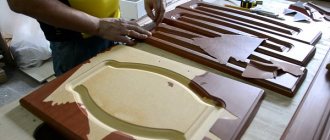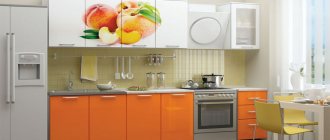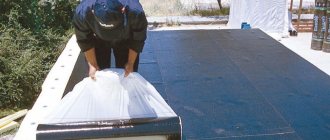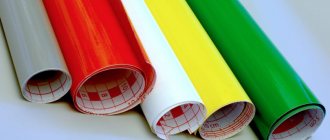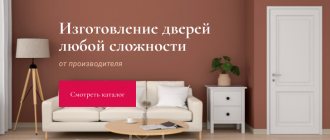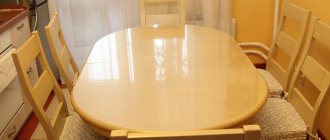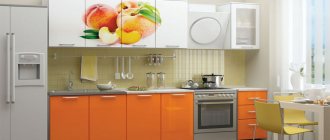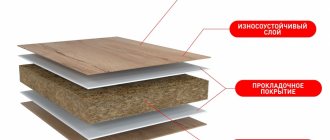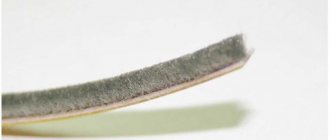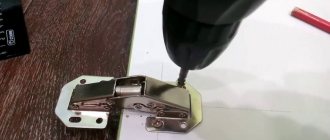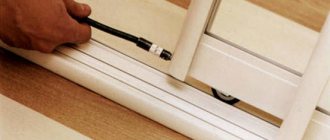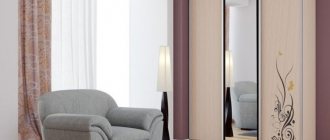dated February 9, 2014
Film facades are a popular modern solution for the front decoration of furniture: they are economical, varied in color, and allow you to imitate various surfaces. But sometimes buyers have distrust in the quality and durability of such furniture. Many people have the impression that these facades are covered with ordinary film, which can be bought at construction or hardware stores. To understand this mistake, you need to take a closer look at the production technology of film facades and their characteristics.
What are film facades? Production of facades with PVC film
Film facades are manufactured using modern technologies based on MDF boards (medium density fiberboard). In terms of their parameters, these boards are close to natural wood, but much stronger. They are non-toxic, do not emit harmful substances, and are environmentally friendly. An important property of MDF boards is that they practically do not absorb moisture.
Traditionally, shaped milling is applied to the facade of the slab using modern high-precision machines, ensuring the quality and clarity of the design. When making custom-made furniture, the design can be made according to the customer’s sketches.
The next technological stage in the production of film facades is the application of PVC film to the prepared elements. Film is a very durable material. Usually it has a thickness of 0.3-0.5 mm. When heated, it becomes plastic. It is this property of the film that is used when it is applied to facades using thermal vacuum pressing. In this case, the film lies evenly on the surface of the slab, easily filling all the milling recesses, and after cooling it retains its shape, holds firmly and for a long time.
The variety of patterns of PVC film is ensured by the fact that it accepts printing patterns well and is easy to emboss and dye.
Therefore, the film can be glossy, semi-matte, matte, pearlescent, with a metallic sheen, imitating various wood species, marble, leather, textiles and other materials. In addition, the film can be patinated and varnished.
Such a variety of designs allows you to use furniture with film fronts in any room, with any interior: warm solid colors are suitable for the bedroom, marble or enamel film for the kitchen, wood-look for the living room.
Of course, all the positive properties of film facades are preserved only with strict adherence to manufacturing and storage technology. If the product is manufactured using outdated equipment, in violation of the conditions of production, storage and transportation, there can be no question of quality: the film quickly peels off and loses color. Therefore, it is very important to purchase products from more or less well-known manufacturers that have proven themselves well in the local or national market.
Melamine film for chipboard cladding.
Melamine films are a modern facing material based on decorative papers of various densities (plain or printed), impregnated with amino-formaldehyde resins with an incomplete degree of polycondensation. (photo from website: bimma.ru)
To obtain a melamine film, you need to impregnate special decorative paper with resin. Impregnation occurs in several stages. On an impregnation machine, resin is first applied with a roller to the underside of the canvas, and then the paper is completely immersed in the resin in the bath. Between the first and second stages of impregnation, the paper passes through a “penetration” zone. As this zone passes through, the resin applied to the underside penetrates the paper and displaces the air from the paper. Thanks to the displacement of air, good saturation of the middle of the paper is achieved in the future.
After the first impregnation machine, the paper is dried, resulting in the removal of volatile substances. Then the fabric enters the second impregnation machine. There, a layer of melamine-formaldehyde resin is applied to both sides of the paper sheet. The purpose of applying a second layer of resin is to give the top layer increased fluidity properties during pressing, as well as to give the facing surface smoothness and increased strength.
The paper then goes into another dryer, which has three heating zones and one cooling zone. Once in the cooling zone, the film sheet enters a roller conveyor (roller table), the rollers of which are cooled by water. This is how paper turns into film. After this, the film is cut into sheets of a given size. These film sheets are stacked on a sheet stacker and packaged.
Source: www.makuha.ru
Advantages of film facades
The main advantage of film facades is their price. Furniture with them is relatively inexpensive compared to some other finishing options. Film facades have other advantages:
- a huge variety of colors and textures;
- durability;
- resistance to abrasion and cleaning agents;
- the ability to manufacture custom products of any size, shape, for example, curly, bent, etc.;
- high light resistance (to UV rays);
- environmental Safety;
- ease of care.
Whatever furniture you come up with for yourself, your plans can be realized with the help of film facades.
Request a call back
Terms of use
By joining this Agreement and leaving your data on the Website www.plastics-foils.ru, (hereinafter referred to as the Website), by filling out the fields of the online application (registration) the User:
- confirms that the personal data specified by him belongs to him personally;
- acknowledges and confirms that he has carefully and fully read this Agreement and the conditions contained therein for the processing of his personal data indicated by him in the fields of the online application (registration) on the website;
- acknowledges and confirms that all provisions of this Agreement and the conditions for the processing of his personal data are clear to him;
- consents to the processing by the Site of the personal data provided for the purpose of registering the User on the Site;
- expresses agreement with the terms of processing of personal data without any reservations or restrictions.
Disadvantages of film facades
Film facades also have disadvantages:
- peeling of the film under the influence of high temperatures and humidity;
- possibility of damage due to external chemical, mechanical influences, or the use of abrasive cleaning agents;
- impossibility of restoration of defects.
Manufacturers of kitchens with film facades strongly recommend purchasing a good hood - it extends the life of the cabinet facades located above the hob.
If the appearance of the film facades suffers greatly, you can always order new ones. Fortunately, their price is low. It is not necessary to change the furniture frames - you can only update the facades. If the facades are made from reliable, consistent manufacturers, you can re-order one or two elements from them at any time to replace the damaged ones.
Film, enamel or plastic - which is better?
Along with film finishing, enamel, acrylic or plastic coating is popular. At first glance, it is difficult for an uninformed buyer to determine the material used for the manufacture of furniture facades. How is film different from plastic and enamel? Which is better to choose? To answer these questions, you need to know the main features of these materials.
Plastic MDF facades. Plastic coverings of facades have a bright glossy surface. Such facades are resistant to mechanical damage, do not deform from exposure to moisture or high temperature, and do not fade in the sun. The colors are varied, but the palette is not as wide as that of film . Plastic facades are perfect for kitchens, bathrooms or hallways. The disadvantages include the higher cost compared to film facades, as well as the fact that handprints are clearly visible on the plastic. Restoration, as in the case of film, is impossible.
Chipboard lamination.
Chipboard lamination is the process of covering board surfaces with paper-resin films impregnated with resins. The combined effect of pressure (25-28 MPa) and high temperature (140-210 ̊ C) causes the film to practically “grow” into the surface of the chipboard. The word “lamination” itself is of English origin and is translated as “layering, rolling, layering.”
Chipboard lamination line, made in China. (photo from website: china1.ru)
Fast lamination line. (photo: elo.ru)
| Feeding the slab into the press. | Multi-vacuum device with reversible strip for film laying. |
Features of caring for film facades
Caring for film facades is really easy. They should be wiped regularly with a damp soft cloth and any non-aggressive liquid detergent.
In order for furniture facades with PVC film to serve for a long time without losing their performance properties, it is recommended to follow a few simple rules:
- do not expose furniture to heat above 70°, do not place it near an electric stove, heaters,
- lighting fixtures, etc., to avoid film peeling;
- do not expose film facades to cooling below -15°, prolonged exposure to moisture or strong mechanical stress;
- Do not use abrasive, aggressive agents, solvents or liquids containing chlorine to clean facades.
If you treat furniture with film fronts with care, it will delight its owners for a long time with its bright colors and smooth surface.
After the blanks are laid on a membrane-vacuum press and the PVC film is stretched, the most crucial and, perhaps, the most intriguing moment of the entire technological process of manufacturing MDF facades begins. However, before you turn on the press, you should study several important indicators.
Characteristics of PVC film for crimping MDF facades.
· PVC film thickness. Varies from 0.2 to 0.55 mm. The maximum possible and minimum required heating temperature of the film surface depends on it. If overheated, the polyvinyl chloride base will melt, which will lead to the formation of melted holes and a violation of the vacuum seal. On some types of films, due to such “toasting”, glossy spots are formed, which negatively affects the appearance of the finished MDF product. At low heating temperatures, the film will not achieve its elasticity properties necessary for successfully fitting the bends of parts and the reaction of the adhesive. Repeated heating of the film to the required temperature reduces its quality.
· Color of PVC film. It also affects temperature indicators during the manufacturing process of MDF facades. Dark shrink films acquire their technological properties at temperatures from 45 to 60 ° C. Light and especially glossy films can heat up to 120-135 ° C.
· Adhesive for PVC film. Here you should take into account the fact that some adhesive compositions are activated only after reaching a certain temperature.
· Room temperature and temperature of the membrane-vacuum press itself. In the hot season, as a rule, the heating process occurs faster, so you should be careful about overheating the film.
Having studied all of the above factors and made the appropriate conclusions, you can proceed directly to the process of covering MDF facades with PVC film.
Crimping of MDF facades with PVC film.
After turning on the heating, the PVC film in the machine begins to “move.” At this moment, you should be wary of the formation of large folds, which may later remain on the MDF facades. However, if you see a crease at the beginning of the heating stage, do not panic. The fact is that the first sign of “readiness” of the film is its stretching. At a certain temperature, all its folds are aligned, and it is pulled “into a string” above the surface of the press table. At this point the vacuum pump needs to be started.
Lamination and lamination of chipboard. Chipboard technology.
Chipboard lamination and lamination technology. Production of laminated chipboard. Decorative coating for furniture boards.
To use chipboard in furniture production, sanded chipboard is subjected to decorative processing - a decorative coating of laminated paper (melamine) films is applied.
At this production site, sanded chipboard is converted into laminated chipboard. The production of laminated chipboards is the process of lining sanded chipboards with paper-based films (laminated paper films).
There are two methods for decorative processing of chipboards with paper-laminated films:
- Chipboard lamination.
- Chipboard lamination.
The main difference between lamination and lamination of chipboards is that during lamination, a decorative coating is created by chemical pressing and is a component of the board, while during lamination, a ready-made solid paper-resin film is glued to the board.
Pros and cons of film facades
In addition to the variety of appearance, the advantages of film for MDF facades include:
- low cost;
- simple application technology;
- practicality in operation;
- high moisture resistance;
- good resistance to ultraviolet radiation (fading);
- environmental Safety.
The disadvantages include:
- Relatively low resistance to mechanical stress. The surface is easy to scratch.
- Low upper threshold of operating temperature (about 80°). Therefore, film for a kitchen table is not the best option - even a cup of hot tea can leave a “whitish” mark.
- It is impossible to restore the surface by grinding or polishing.
Kitchen furniture has the highest risk of damage - this is where it experiences high mechanical and thermal loads. But all these shortcomings are compensated by the possibility of updating using self-adhesive film for the kitchen.
Manufacturers
Good film is produced in Germany - it has proven itself well on the Russian market. The coatings of the German company Pongs have long been known and loved among consumers.
And film from German companies such as Klöckner Pentaplast and Renolit Prestige class is very popular among manufacturers of windows, doors and furniture.
In the Prestige series you can find very extravagant options. Manufacturers follow new fashion trends and try not to deviate from this. The only negative is that the products are expensive.
Products from Chinese manufacturers are no less in demand - a wide range allows you to choose the best option to create the desired design.
High-quality coating is also produced in India, but Chinese products are most often brought to Russia. People have a stereotype that China produces bad things, but this is not true. Chinese PVC film factories create exactly what the consumer orders. Fulfilling any of his wishes and meeting all requirements, the coating is created in any color, thickness and quality.
Of course, more durable film costs more. If you need to purchase an inexpensive film, it will be somewhat worse in quality, for example, thinner, and may crack in the cold.
What are MDF facades in PVC film?
PVC film for furniture facades is a polymer material made of polyvinyl chloride, 15-80 microns thick, used for covering furniture made of MDF and chipboard, as well as for self-gluing.
Furniture facades are usually made of wood or wood materials: solid hardwood, chipboard and MDF (. There are also “curvilinear” or “radial” doors of cabinets and cabinets, but this is a separate category, although in this case plywood is bent on the matrix, special grade MDF or gluing together several sheets of fiberboard.
Each type of facade has its own “set” of decorative processing options. The most limited choice for chipboard is only lamination at the factory, followed by gluing the edges of the blanks at the ends. Chipboard facades are straight slabs that cannot be milled, sanded or painted.
And MDF facades have the most possibilities for finishing and processing. They, like chipboard, can be laminated at the factory and imitate any “smooth” or “voluminous” texture. The slabs can be milled, sanded, painted, and enamel applied. But the most economical option for decorative finishing is gluing MDF parts with PVC film.
In factory conditions, facade production looks like this:
- cut out the part;
- if necessary, mill a three-dimensional pattern;
- polish the surface;
- pressed with PVC film.
What printers are used to print on PVC plastic?
Printers such as Epson, Mimaki, Millenium, Zebra are suitable for printing at home. They provide high-quality widescreen images. These devices have convenient compact housings.
Special equipment is used to print on thin PVC plastic. It is selected according to the thickness of the material. Preference should be given to printers that can print an image on A3 sheets in 3–5 minutes.
Additional devices for inkjet or laser printing on PVC plastic:
- large format UV plotters;
- digital cutters for contour cutting;
- devices for subsequent processing of the material (embossing, cutting, embossing).
Unsuitable equipment may cause image deformation. This usually happens during pattern processing (folding, gluing, embossing). To avoid this, when choosing a printing device, pay attention to the adhesion of a particular material.
Types of self-adhesive PVC film
The film is responsible for the decorative appearance of doors and drawer front panels. She may be:
- matte, glossy, semi-matte;
- monochrome, with a geometric or abstract pattern;
- with imitation of the texture of stone or wood cut;
- with mother-of-pearl or metallic shimmer;
- with sparkles or flocks (colored splashes).
Such wide decorative possibilities are one of the main reasons for the popularity of MDF facades in PVC film.
Self-adhesive decorative film consists of three layers:
The front layer is the polymer film itself.
Materials used
- Polyurethane varnish OR 383
- Solvent D1010 polyurethane universal
- Hardener C376A for varnish
- Acetone
- Patina
Consumption rates for paints and related materials per sq. m. for patination are given in Table 1.
| No. | Name of material | Unit | Quantity |
| 1 | MDF (16, 19 mm) | m. sq. | 1.080 |
| 2 | PVC film | m. sq. | 1,9 |
| 3 | PU dispersion DUOPUR 1 K | kg | 0,0855 |
| 4 | Varnish OR 383 | kg | 0,100 |
| 5 | Paint hardener C 376 A | kg | 0,050 |
| 6 | Solvent D 1010 | kg | 0,042 |
| 7 | Acetone | kg | 0,250 |
| 8 | Patina | kg | 0,080 |
| 9 | Packaging film (stretch) | m. linear | 7,5 |
| 10 | Film - foam | sq.m. | 0,8 |
| 11 | Corrugated cardboard | sq.m. | 1,25 |
| 12 | Scotch | roll | 0,05 |
How to choose PVC film for MDF facades
There are two selection criteria:
- compliance with interior design requirements;
- minimizing waste when cutting and fitting.
The first criterion determines what kind of adhesive film with a pattern should be for the kitchen. For traditional interiors, materials that imitate the texture of wood are usually chosen. Whether these shades are light or dark is determined depending on the finish of the walls and floors, the size of the room, the location of the kitchen and the level of natural light.
The classic option is to decorate facades with white film.
And lovers of bright colors can easily update their kitchen with self-adhesive film in red or yellow.
One of the most common options for transforming the interior is the use of self-adhesive film for the kitchen apron. In addition to monochrome types of finishing, materials with geometric patterns or imitation stone textures can be used here.
And waste can be minimized only if the amount of material is correctly calculated, taking into account the width of the rolls and the geometry of the surfaces being restored.
Important! You should also take into account the features of the pattern - some types have a clearly visible “step” and “top-bottom” direction.
Interior renovation using film
Designers love polymer films. They have good plasticity and decorative properties; with their help you can quickly update almost any surface. Material suitable for decoration:
- tiles in the bathroom or kitchen;
- wall panels;
- doors;
- different furniture.
Films are available in different colors, with and without patterns. With their help, you can update your kitchen set and change old furniture in your home without extra costs. After all, the price of even the most expensive film will be cheaper than a new headset.
Restoring tiles with vinyl is not difficult
It is important to choose the right drawing here. Delicate chintz designs or films with textured embossing are suitable for the kitchen.
Before gluing the tiles in the bathroom, you need to carefully prepare the surface - degrease it well. Otherwise, the film will quickly peel off.
Brick Adhesive Film for Kitchen
We have already studied options on how to make a brick wall in the kitchen. Another solution is “brick-like” film. The main thing is not to miss the mark with the color, otherwise you will end up with a Soviet factory workshop in your kitchen.
Paintings on kitchen facades
There is a large selection of patterns and paintings with which you can easily decorate your kitchen space. For connoisseurs, you can transfer some objects of art or landscapes to the surface. In this case, you should choose expensive films, because large, bright, low-quality surfaces will immediately appear in your eyes.
Decorative pattern for a white kitchen
White facades are a universal place for decoration; practically any patterns and stories, colors and shapes can be placed on them. You can use different designs for the top and bottom.
Covering kitchen units with film at home
To successfully cover a kitchen façade or splashback with MDF at home, you need to carry out the preparatory stage correctly. It consists of the following points:
- Preparing facades for pasting . To improve the adhesion of the adhesive base to the part being restored, it must be cleaned of dust and dirt and degreased using detergents based on alcohol or quaternary ammonium. If there are deep scratches and chips, they need to be puttied.
- Preparing the walls . To stick it as a kitchen apron on a plastered wall or drywall, the surface of the base is puttied, sanded and coated with a primer. Painted walls are cleaned of dust and degreased.
- Preparation of materials . Before starting work, the film for the kitchen facades and apron is unrolled, the information on the back is read, and patterns are made in accordance with the marking grid and the dimensions of the parts (surfaces).
Note. To replace the film on a kitchen facade with a relief surface, a new blank must be cut with a small margin. It is better to trim off the remainder of a couple of extra centimeters than to cut out a new pattern if there is not enough material.
The gluing process occurs for each part separately.
Important! It is necessary to ensure that when pasting the facades of one pencil case or the door of a bedside table and a drawer above it, the drawings of the upper and lower parts fit together in direction and, at least approximately, coincide in step.
The work is carried out in the following order:
- They try the pattern on the part and make sure that it fits neatly in place.
- Remove the edge of the pattern by approximately 5 cm from the protective paper. And carefully align it with the edge of the part, trying to avoid distortion.
- Gradually remove the paper backing and roll the pattern onto the surface of the facade. The principle of pasting is similar to working with wallpaper - smoothing is carried out from the center line to the edges, trying to drive the “bubbles” beyond the border of the part.
- To paste over relief parts with internal corners and edges, the film can be slightly heated with a regular hairdryer to make it more flexible and “softer”.
- If a fold or crease is formed, or if the pattern is shifted to the side relative to the axis (border) of the part, the façade film for the kitchen must be carefully separated from the surface and re-glued.
Important! The glue is not fast-drying - its polymerization time is long enough to correct errors in laminating MDF with PVC film.
Video on how to cover a kitchen unit yourself with film below:
Watch the video of how to cover a kitchen façade with self-adhesive film with printing:
The best PVA-based adhesives
PVA glue for wood is in demand in office supplies, as well as when working with wood. Such an environmentally friendly product will not leave marks, has a strong adhesion, but does not withstand moisture well. When comparing 8 products, it was determined which one is better. The list contains 4 of them.
Kiilto PVA D3
The product is known for its white color and thick composition. The best glue for wood, as it has moisture-repellent properties, is able to withstand 5 freezing cycles down to -40 degrees, maintaining all the basic qualities. Currently produced by a large number of developers, including the Finnish brand - Kiilto.
Advantages:
- Safe, based on water dispersion;
- Available in 1 and 3 liter packaging;
- Cost-effectiveness;
- Fire resistance;
- Promotes sound insulation;
- Thermal resistance.
Flaws:
- You need a brush or roller to use;
- Applicable only at +10 degrees.
Based on reviews, the product will create a reliable connection and has a wide temperature range. In view of this, all materials that are of wooden origin are glued together.
Moment Super PVA D3 moisture resistant
The Russian wood glue Moment Super PVA D3 is moisture resistant and has good operating characteristics. It is used to glue various objects made of wood, veneer and materials containing wood inclusions. The product is slightly inferior to the leaders in the duration of setting (15-20 minutes) and complete drying (days).
PVA glue for wood will not leave marks on the material after drying. The water dispersion will retain its qualities at temperature parameters from +5 to +30 degrees. This characteristic feature is indicated by buyers in responses as a minus of the product. Consumers note the reliability, transparency, and availability of the adhesive composition in question.
Advantages:
- Transparency;
- Withstand static load;
- Versatility;
- High water resistance;
- There is no unpleasant aroma.
Flaws:
- Cannot cope with dynamic load;
- Properties decrease at sub-zero temperatures.
Moment Super PVA D3 moisture resistant differs from analogues in a longer compression time (20 minutes). Complete drying will occur after 24 hours.
PVA professional Tex Universal
Various materials can be glued together using TEX PVA Joinery Professional. Among them are wood, cardboard, paper products, leather, linoleum. Bonding strength is achieved due to excellent adhesion. At the same time, the seam is characterized by increased reliability and elasticity.
The composition is white, which should not alarm the consumer. After drying, it will become transparent, so it will not spoil the formed knot. Experts note the comfort during work and the absence of unpleasant odors. The adhesive composition deservedly occupies a leading position in the ranking. Experts note the strength of adhesion. The downside is the high consumption of glue; it dries after 1 day.
Advantages:
- Versatility of use;
- Non-toxic materials;
- There is no unpleasant aroma;
- Comfortable packaging;
- Proper strength.
Flaws:
Uneconomical use of material.
Based on reviews, PVA Tex is a universal wood glue. It is produced in a comfortable package that is easy to use. Equipped with an ergonomic lid, the gluing process is fast and reliable.
PVA Lakra Builder universal
High quality product based on PVA water dispersion. PVA Lakra Builder universal is characterized by increased setting reliability and quick drying. Upon completion of setting, a flexible transparent film is formed. The composition is recommended by experts for carpentry: gluing wooden objects, furniture, gluing linoleum (made of fabric), leather goods, cardboard, paper.
Advantages:
- Excellent adhesion to paper and wood;
- Materials are non-toxic;
- Just wash;
- No aroma;
- Economical spending.
Flaws:
Flammability of materials.
Based on reviews, the adhesive is distinguished by a thick, homogeneous composition without lumps or foreign impurities.
Features of caring for film facades
Caring for film facades is simple. Both dry and wet cleaning are suitable for them.
Dry cleaning is carried out using soft wipes for the care of delicate surfaces. Large areas can be cleaned of dust using a vacuum cleaner and a long-bristle brush attachment.
Wet cleaning is carried out with warm water and soapy water. Heavy contamination is removed with household detergents based on alcohol or quaternary ammonium.
Important! It is prohibited to use abrasive cleaning agents, hard brushes, scrapers or any other devices for mechanical cleaning - they leave scratches on PVC film facades.
Anyone can reupholster kitchen facades with film - no special tools or professional skills are needed for this. The main thing is to be careful and attentive to details. As a result, the old kitchen will be transformed and will last for several more years.
Patination defects and causes of their occurrence
Only single bubbles, craters with a diameter of no more than 1 mm, punctures, mechanical inclusions with a size of no more than 1 mm, scratches, and two noticeable shagreens are allowed on facade surfaces.
The total number of simultaneously present defects listed above per 0.5 sq. m. surfaces from among the permissible (quantitatively assessed) - no more than 2 pieces.
The main defects in patina finishing and their causes are presented in Table 2.
Main patination defects and their causes
| Coating defect | Possible reason |
| 1. Uneven application of patina | Poor preparation of the base, incorrect application technique, inappropriate type and parameters of the spray gun |
| 2. Peeling and poor adhesion of patina and varnish | Poor preparation of the base, incompatibility of materials, excessive application of patina and varnish |
| 3. Varnish smudges | Incorrect application process, inappropriate nozzle diameter, low paint viscosity, wrong thinner |
| 4. Uneven application of varnish | Unskilled application technique, poor preparation of the base. |
